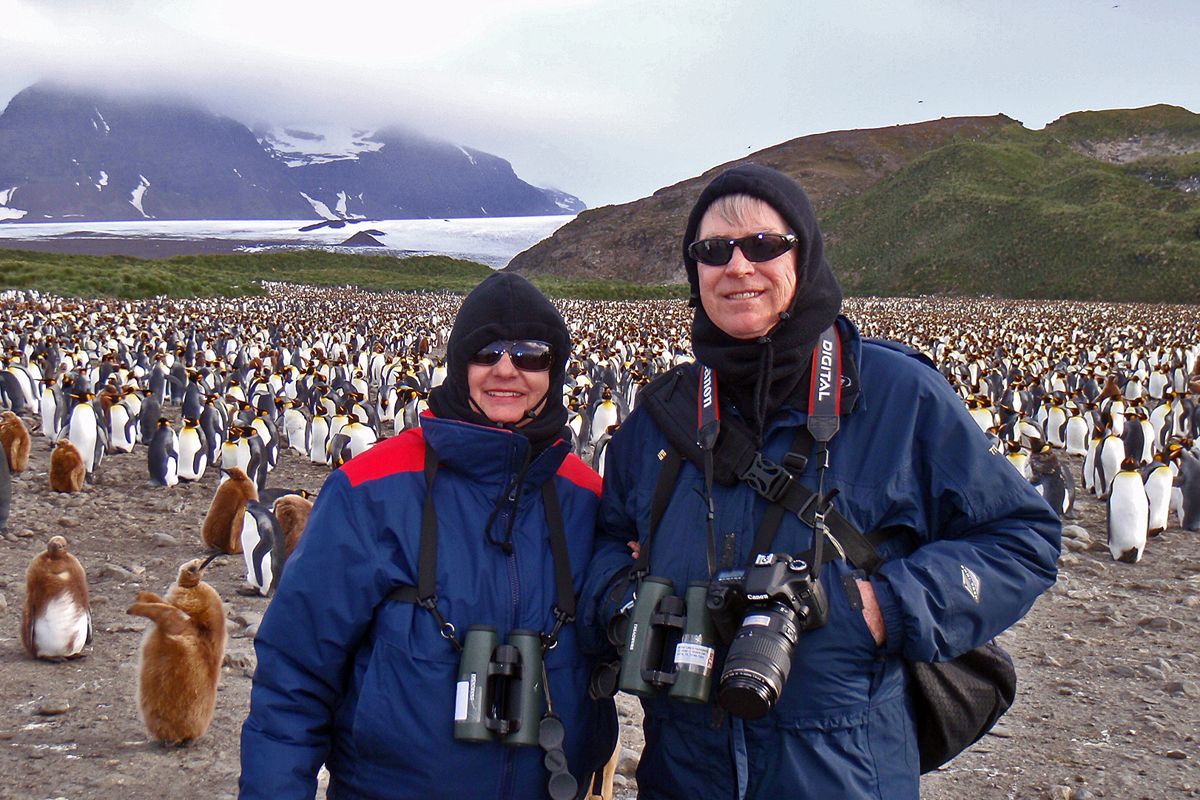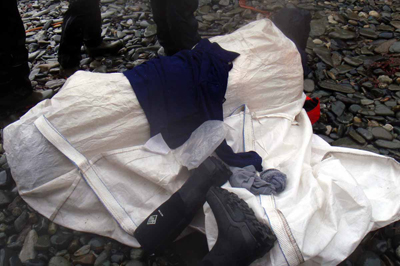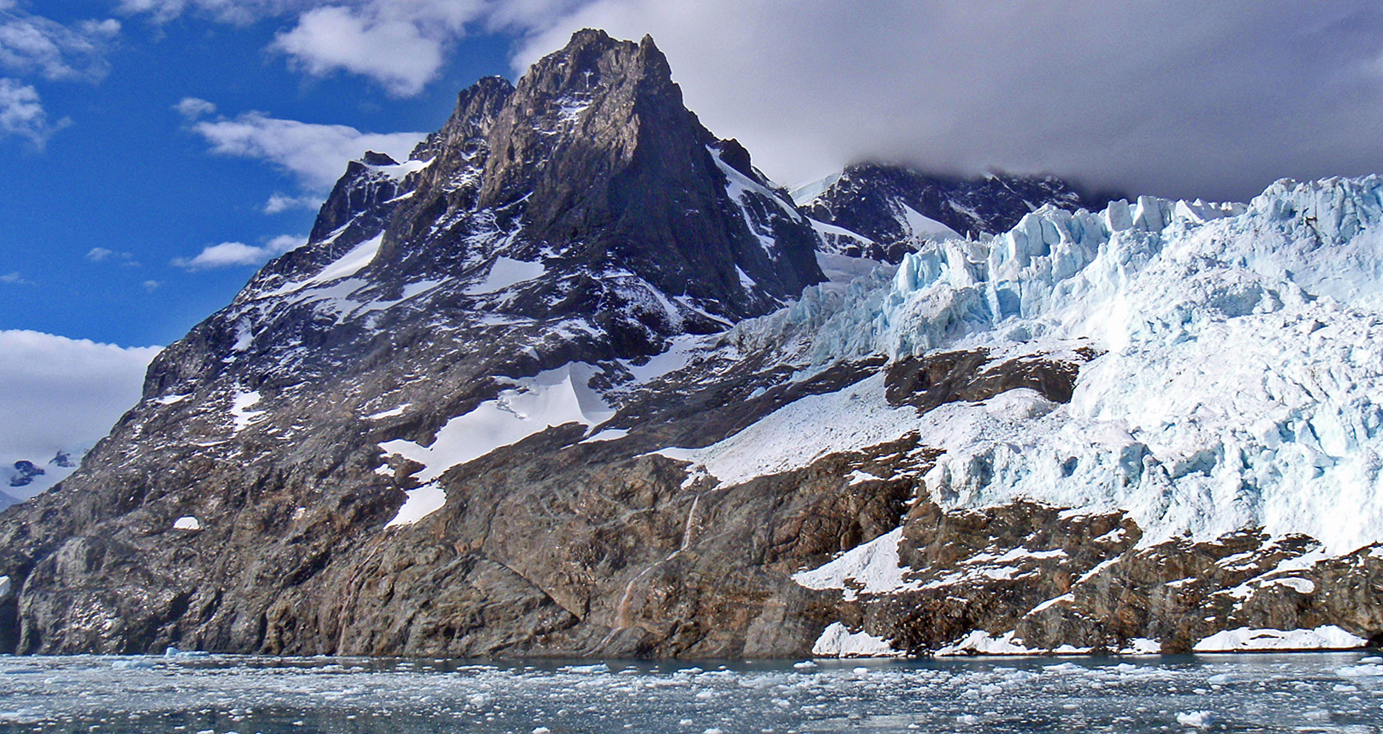Note: This is a rather long article. If you prefer to print it out, use this version.
The day began beautifully, a dingle day in Antarctic slang, and ended with a spectacular view of the Drygalski Fjord and the first Snow Petrel I’d ever seen, but in between, I regretted my unbelief, contemplated my own mortality, got hypothermia, and made a New Best Friend™.
 |
Linda and Jim with King Penguins
Here’s how it happened.
The day before, we did what most visitors to South Georgia do. We landed at Salisbury Plain, site of a huge King Penguin colony, which held an estimated 250,000 pairs, not to mention the chicks, adding credibility to the idea that we saw “millions” of penguins on our cruise to the great Southern Ocean. We took some great photos, subsequently lost. That’s part of the story. Here’s a picture of the two of us with some of the penguins, taken with my wife Linda’s rugged and waterproof point-and-shoot camera.
You’d think that would be enough. Not for birders! We had yet to see the South Georgian Pipit, a species that, as the name implies, lives only on the Island. Thus, after a short cruise during the night, our ship anchored for our final trip ashore near Cooper Island, a rat-free enclave known to be a nesting site of the Pipit. Rats, specifically the Brown Rat (Rattus norvegicus), are a major problem on South Georgia Island, and have decimated the Pipit population.
We woke to an unusually clear blue sky and calm seas. After a short ride in a Zodiac, a shallow, allegedly unsinkable contraption that held 12 people, we arrived on the rocky shore of Cooper Bay. Cooper Island itself was off-limits to humans. We quickly located several of the Pipits. We also watched nesting Macaroni Penguins with their attendant Snowy Sheathbills, birds that eat Penguin shit if you can believe it. We saw many Antarctic Fur Seals, including some young pups, and managed to intimidate one that got aggressive. After about an hour of this, we returned to the Zodiac for a tour of some of the nearby coast.
During this excursion, some gravity-driven katabatic winds arrived. We had never heard of these winds before the trip. They arise when cold air over an ice sheet flows downhill, accelerating as it does so, before arriving suddenly with great force at the bottom, in our case, the bay. In minutes, the sea was full of 1-2 meter waves, and strong winds. Our bird guide, Steven, suggested to our Russian boatman that we return to the ship.
We tried.
During the trip back, waves poured over the bow and sides, drenching everyone. Some seawater a few degrees above freezing ran right down the neck of my jacket. I thought about my camera, stowed in what I hoped was a waterproof pack. The pack wasn’t as waterproof as I wished; the camera never worked again. The frigid water even wiped out the memory chip. I didn’t know you could do that.
We were the third Zodiac in line for a turn to scramble up the gangway and onto the ship. We circled in the bay watching as Andy, a birder in the first Zodiac, got back aboard our ship, Plancius. “Great,” I thought. “If he can do it, so can I.” That’s when the radio crackled out something I thought was Russian, but must have been English, as Linda understood it. Steve repeated the message, “We’re going to return to the shore.”
My first thought was, “There’s nothing on the shore to burn. How are we going to get warm?” I noticed a large waterproof box on the floor of the boat, which I trusted contained survival supplies. Prayer seemed appropriate, until I realized I had no one to pray to, and commented, “At times like this, I regret being an atheist.” That got a couple of laughs.
The Icelanders, who converted to Christianity in the Eleventh century, were pragmatic about prayer. One Viking admitted, “On land, I pray to Jesus, but on the ocean, I pray to Thor.” The latter was supposed to control storms. I didn’t think Thor would be much help, and in fact, he wasn’t, but I gave it a try anyway.
At that point, it occurred to me that I might die.
Click to read more…
This was not the first time I had thought that. The first time happened at Dallas-Fort Worth airport, in a fully loaded 747 with enough fuel to reach Paris, when the pilots, concerned about a warning that a cockpit window wasn’t shut properly, aborted takeoff at the last second. I remember grabbing Linda’s hand and commenting, “This is the worst case scenario,” as the plane shuddered to a stop, blowing out four tires in the process. We survived that incident, which was probably more dangerous than our present situation.
“Don’t be ridiculous!” I told myself. “We’re not going to die! I haven’t logged the sighting of the South Georgian Pipit yet.”
Linda sitting across from me, and just as wet, reflected on a movie we had just seen about the trip of Ernest Shackleton in 1914-1917. All the crew members survived over 700 days in the Antarctic. She comforted herself with the idea that we could certainly survive a couple of hours. I wish she had shared her insight with the rest of us in the boat. Instead, she said, “Next trip, I pick the destination.”
By the time we got to the shore, I was shivering uncontrollably. The man sitting next to me — I think his name was Colin — shouted, “This guy is experiencing first stage hypothermia. Somebody needs to do something.” They passed me on to the ship’s doctor, who started me on a series of calisthenics that didn’t seem to be helping much. Fortunately, Shane, the guide specializing in the history of the area, took charge.
Shane, who had spent 25 years guiding trips down the Grand Canyon, was familiar with the problem of hypothermia. “We have to get you out of these wet clothes,” he said, pulling on the zipper of my jacket at the same time. After the jacket, he removed my fleece layer, my shirt, balaclava, and even the top of my thermal underwear. Soon, my boots, socks, rain pants, and inner pants joined the pile of clothing on the ground, leaving me with only the bottom of my thermals to preserve my modesty.
“I have some dry socks in my bag,” I suggested, trying to be helpful.
“Get into this,” Shane instructed, holding open the top of a large white plastic bag. Normally, we used the bag on shore to contain the life preservers, to prevent them from contamination by Sheathbill food. Apparently, this bag was all I was going to have to keep the wind away. I got into the bag without argument.
Then, my New Best Friend™ arrived in the person of Anjali, a petite 36-year-old female guide of German-Indian extraction, a PhD in Marine Science, a veteran of 19 months on South Georgia with the British Antarctic Survey, an accomplished performer of traditional South Indian Dance, and easily the cutest member of the staff. She announced, “I’m going to get in there with him.” She proceeded to doff her own top layers, leaving only dry thermals, and climbed into the bag, where she immediately seized my legs in a powerful scissor lock, wrapped her arms around my neck, and lay on top of me.
My first thought was, “Man. She’s strong.” It turns out that Anjali is also a devotée of extreme sports, including things like ice climbing.
My second thought popped into my head when I rested my hands on what seemed like the obvious place. Without thinking, I blurted out, “You’ve got a really nice ass.”
“Thanks,” she replied, adding, “Why don’t you put your hands under my shirt — and don’t get any ideas.”
I complied.
I asked if she had a boy friend, and if he was big, strong, and the jealous type. She told me that he was in Seattle, was big and strong, but not jealous. I relaxed a bit.
At this point, most people want to know what Linda was doing all this time. The answer: She was taking a picture of us in the bag.
 |
The infamous plastic bag, with assorted cast off clothing
She explained that she was so wet herself that she didn’t think it would do much good for her to get in with me, and found her own plastic sack to ward off the wind.
Anjali and I had time to chat. I pointed out that 36 was a fascinating year. Besides being one year younger than my daughter, it was 22×32. Unless you live to 100, 36 is the only time in your life that your age has the pattern of a product of squares. She was about as interested in that fact as most people.
I mentioned an old song appropriate to our situation with the title “If I said you had a beautiful body, would you hold it against me?” According to Wikipedia, it was by The Bellamy Brothers and was #1 for a while in 1979. Supposedly, the title was a quote from Groucho Marx. Anjali can be excused for not knowing this country music classic, as she was six at the time.
At this point, most of the men who have heard this story suggest that I need better material.
A woman I didn’t recognize appeared at the bag opening with a cup of hot water and some chocolate. Apparently, the survival kit did contain something useful. At the same time, Shane thrust an orange plastic thing into the bag and told us to use it as a second layer. He also told me I needed to drink something hot, so I took the water and drank it.
This involved some rearrangement of bodies. Anjali lifted her head out of the way, doing a yoga pose called the cobra, and I managed to slurp the water without spilling too much. I handed the cup back and there we were, inches apart, eyes locked on each other, just Anjali and me. My right brain recognized a scene from hundreds of movies and urged me on. “Kiss! Kiss!” it insisted. Meanwhile, the left brain was waving a flag with a desperate plea, “No! No! Stop! Bad idea! Weren’t you paying attention?”
Alas, the rational part of my brain won out. I lay back and Anjali rested her head on my shoulder. Her hot breath on my arm felt great.
“You know people are going to be talking about us for the rest of the trip,” she observed.
“Bring ‘em on,” I replied.
Gradually, I stopped shivering and warmed up some. Linda says it was about 30 minutes. I thought it was much longer, an hour at least. They put us in the last Zodiac to return to the ship, perhaps catering to my lack of proper clothing. Someone had rounded up some spare items from other people. I had two shirts, a sweater, two caps, and some great pants. I had to make do with my own boots, which were only slightly damp. Shane instructed me to wrap the orange plastic thing around me on the trip back and asked me if I could manage that. “Sure,” I told him. I felt fine by this time.
The sea was like glass, the katabatic winds having vanished as quickly as they appeared. Our return to the ship was uneventful. I was the first one off the Zodiac, clambering quickly up the gangway, a great relief to the other passengers, who had feared they might need to carry me.
On board, I accepted a cup of coffee, remembered to clean the penguin shit from my boots, flipped my tag to show that I was safely back aboard, and headed to our cabin. The doctor arrived with instructions, “A warm shower, then get into bed. You need to stay in bed an hour at least. Make it two hours.”
By the time I had finished the shower and climbed beneath the down comforter, he reappeared with two hot water bottles. Linda disappeared and returned with a bowl of soup and hot tea from lunch. She left me alone to sleep.
 |
View of the Drygalski Fjord
After one hour, the PA system announced that the ship was entering the Drygalski Fjord. That was all the incentive I needed to get out of bed, doctors orders or no, dress and head to the upper deck for the view, which was spectacular, as I said earlier.
As we moved slowly past the glacier-covered mountains, I was rewarded with the sight of a Snow Petrel, its pristine white plumage accented by a coal black bill and eye, as it rose from an ice floe and sailed serenely across the bow of the ship.



